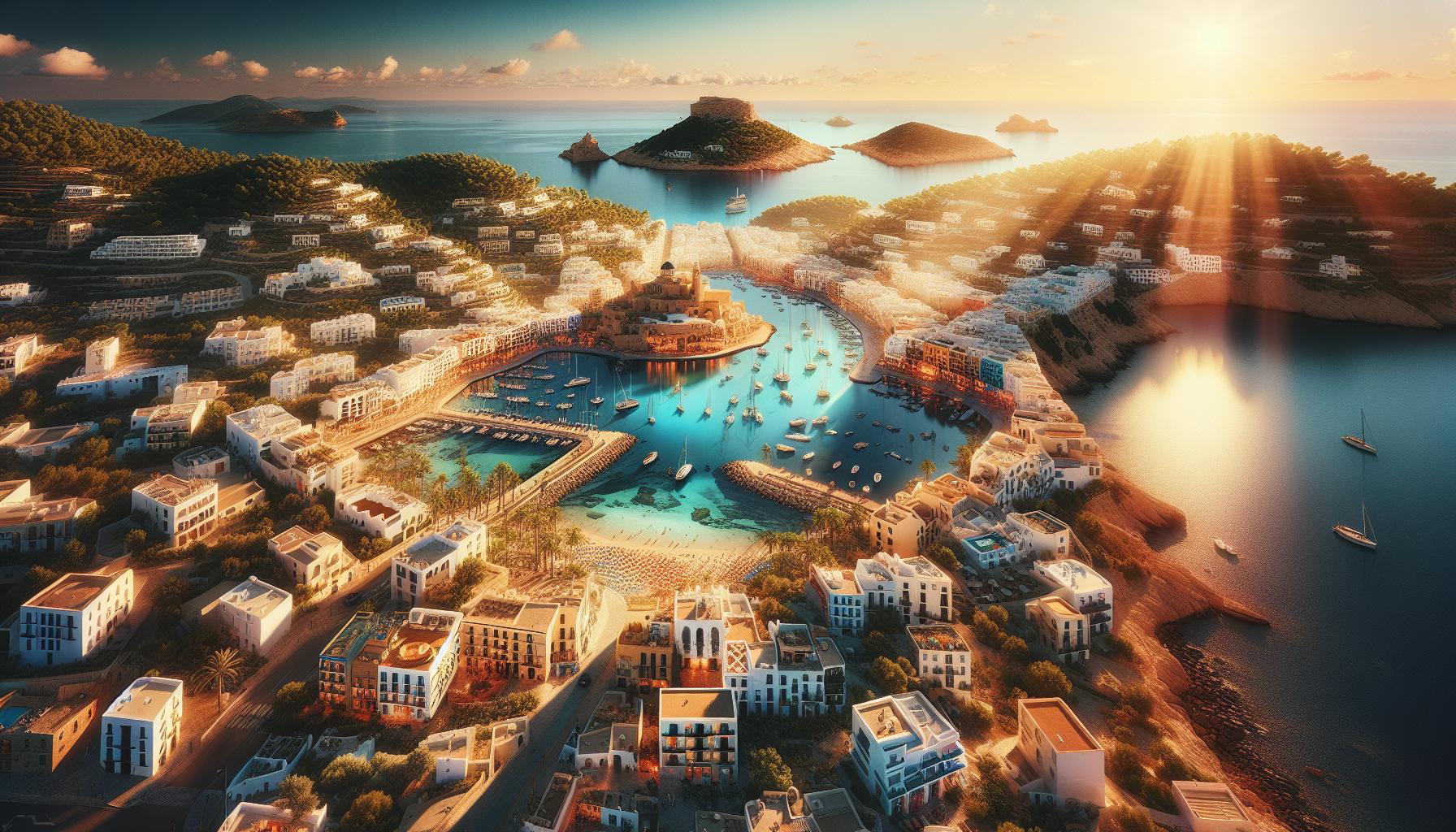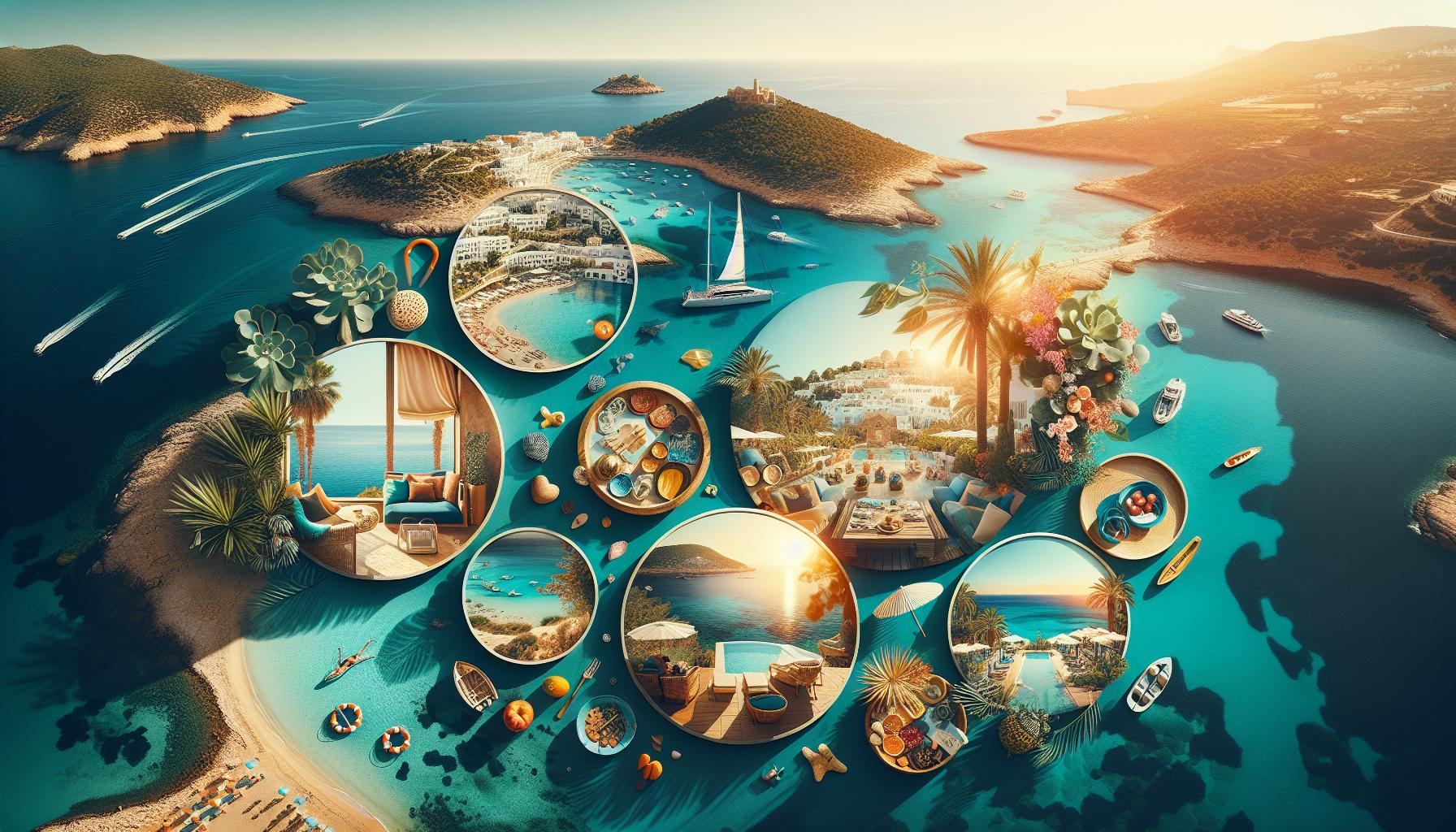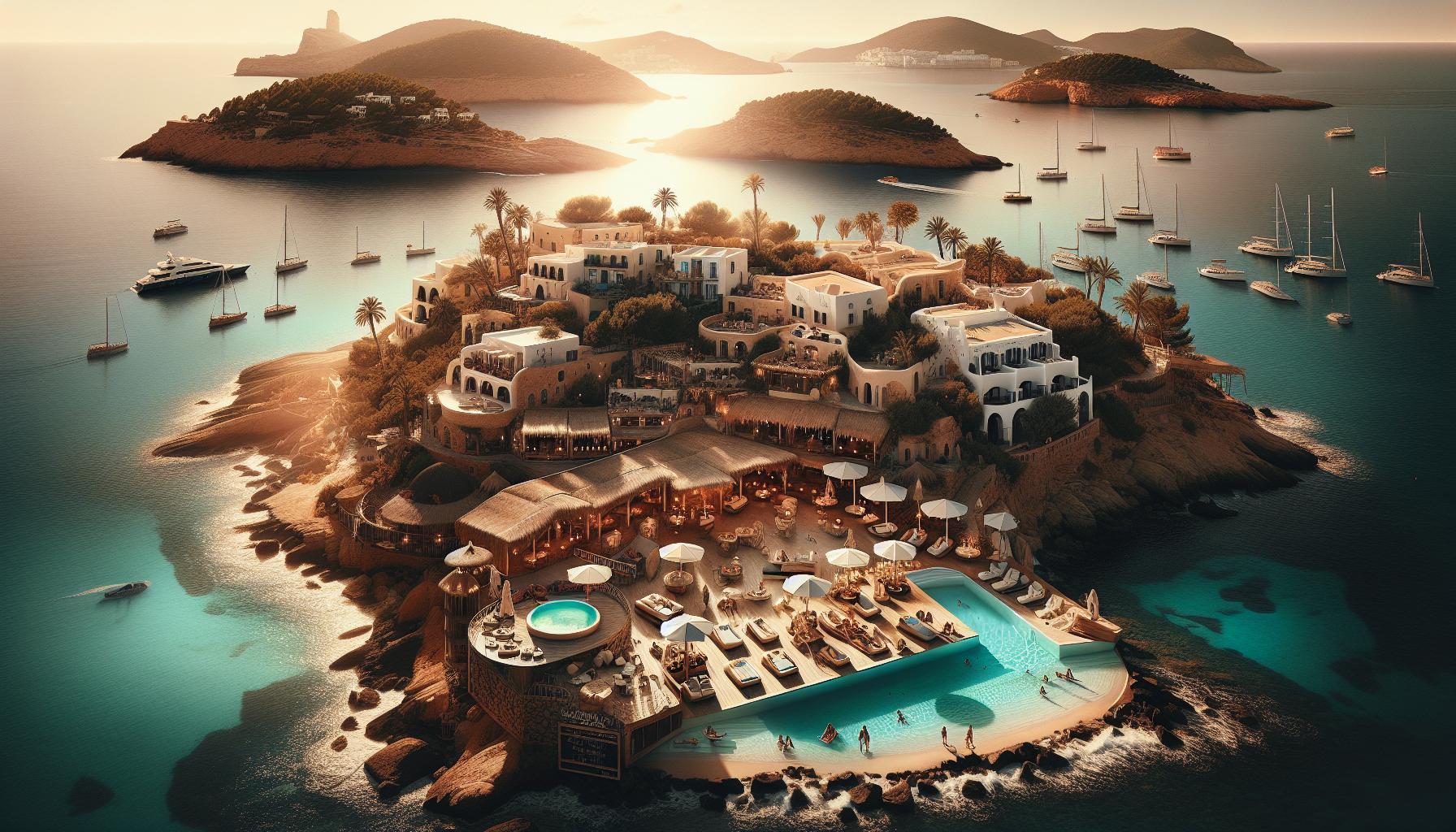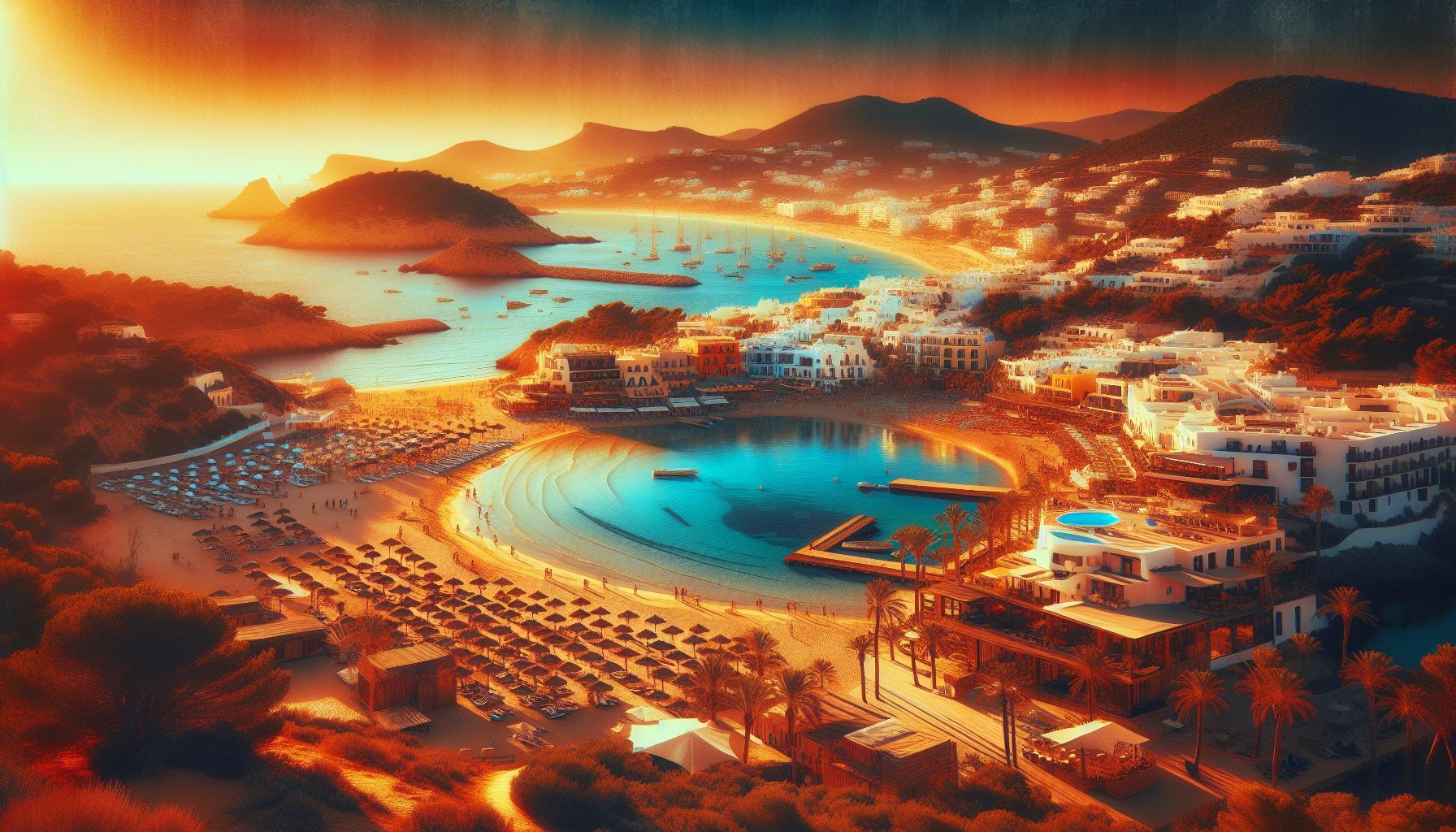Ibiza, famed for its vibrant nightlife and stunning beaches, is often celebrated as a top tourist destination. But what fuels its allure is not just its culture—it’s also its unique geographical features. Understanding whether Ibiza is truly an island and exploring its distinct landscapes sheds light on the natural beauty that enhances its appeal and attracts millions every year.
Understanding Ibiza’s Geographic Identity: Island or Not?
Ibiza, known for its vibrant nightlife and stunning beaches, is undeniably an island, yet its geographic identity encompasses much more than this simple classification. Nestled in the Mediterranean Sea, part of the Balearic archipelago, this Spanish island is the third largest by area and the second by population among its peers, wich include mallorca and Menorca. The questions around Ibiza’s geographic identity can delve into its unique features, from its geographical formation to its rich and diverse ecosystems.
The Foundation of Its Identity
To understand Ibiza’s geographic identity fully, it’s essential to consider its geological origins. The island emerged from the geological uplift of the seabed and is characterized by its mountainous terrain and rugged coastline. The highest point, Sa Talaia, reaches 475 meters above sea level, showcasing the island’s dramatic landscapes. Additionally,the proximity of Ibiza to the mainland,approximately 150 kilometers from Valencia,adds an intriguing context to its island status. Consequently, the demographics, culture, and ecosystem of Ibiza have evolved in ways that reflect both its island nature and its ties to the iberian Peninsula.
Ecological Diversity: an Island Like No Other
Ibiza’s geography is not merely a backdrop for its festivities; it plays a crucial role in its biodiversity.The island is home to numerous endemic species of flora and fauna, which thrive in its varied habitats—from rocky cliffs to sandy beaches and pine forests. These ecosystems contribute to Ibiza’s charm and ecological health, making it a UNESCO World Heritage Site. This classification emphasizes the importance of preserving its unique landscapes and biodiversity.Moreover, Ibiza’s mild Mediterranean climate supports a rich agricultural landscape, characterized by local produce such as figs, olives, and various herbs. This ecological diversity not only supplements the island’s economy but also draws in a notable number of eco-tourists, keen to explore the island’s natural beauty beyond its well-trodden party scenes.
Navigating Ibiza’s Identity: Island Tourism
For visitors aiming to explore Ibiza, understanding what makes this island distinct is vital for a fulfilling experience. Here are some practical steps travelers can take:
- Explore Nature Reserves: Visit sites like the Ses Salines Natural Park to appreciate the island’s natural beauty and biodiversity.
- Engage Locally: Support local farmers and artisans by purchasing organic produce and handmade goods,fostering a deeper connection with the island’s culture.
- Participate in Eco-Tours: seek out eco-tours that focus on Ibiza’s natural habitat, encompassing everything from bird watching to guided hikes through its unique landscapes.
while Ibiza is clearly recognized as an island, its geographic identity is shaped by much more than its physical boundaries. The interplay of its geological history,ecological richness,and cultural dynamics creates a multifaceted island experience. understanding these aspects not only enriches one’s visit but fosters a greater recognition for this Mediterranean gem.
the Enchanting Landscapes of ibiza: More Than Just Beaches
The stunning landscapes of Ibiza extend far beyond its famed sun-kissed beaches, offering a diverse array of natural beauty that captivates both visitors and locals alike. This enchanting island,known for its vibrant nightlife and tranquil retreats,also boasts hills,cliffs,and lush valleys that tell a different story — one that is rich in biodiversity and breathtaking scenery. As part of the Balearic Islands, Ibiza’s geography features several unique elements: hilly terrain rising up to 400 meters, intricate coastlines filled with idyllic bays, and striking coastal cliffs that provide stunning views of the Mediterranean Sea.
Exploring Ibiza’s diverse Geography
Ibiza’s geographical layout is a blend of crystalline waters and rugged landscapes. Visitors who venture beyond the beaches can discover picturesque hiking trails that lead to hidden coves and panoramic viewpoints. The island’s interior is characterized by rolling hills adorned with Mediterranean vegetation, such as pine forests and fragrant herbs, while the coastal regions are peppered with charming fishing villages that showcase the island’s rich cultural heritage. Key features of Ibiza’s geography include:
- Bays and Coves: Numerous secluded beaches and quiet coves are perfect for relaxation or water sports.
- Hills and Cliffs: Dramatic cliffs and hills provide stunning vistas and opportunities for hiking.
- Flora and Fauna: The island hosts a variety of ecosystems that are home to diverse plant and animal species.
- Seasonal Changes: The population swells during peak tourist seasons, illustrating the island’s allure as a summer hotspot.
Flora and Fauna: A hidden Treasure
Delving deeper into the natural aspects of the island, Ibiza’s varied ecosystems present a rich tapestry of flora and fauna. the interior is mostly covered in picturesque hills, where visitors can encounter unique wildlife and indigenous plants. This biodiversity is protected within various natural reserves, making it an ideal destination for Eco-tourism. Observing birds, such as the endangered Balearic shearwater, and exploring aromatic herb fields can provide a serene and rejuvenating experience.
The abundance of landscapes across Ibiza not only enhances its aesthetic appeal but also supports a range of outdoor activities that showcase the island’s beauty. Whether hiking in the natural parks, cycling along the coastal paths, or simply taking a leisurely drive through the interior hills, exploring Ibiza offers a connection to nature that complements its vibrant social scene.
Ibiza’s captivating geography encapsulates more than just stunning beaches.From its rolling hills to its picturesque coves, this island is a mosaic of natural wonders waiting to be explored, offering a unique perspective that complements its well-known allure as a premier holiday destination.
Exploring Ibiza’s Unique Ecosystems: Flora, Fauna, and Natural Wonders
The rich diversity of ecosystems around Ibiza is a celebration of nature’s brilliance, making it a captivating destination for eco-enthusiasts and casual travelers alike. From its lush marine environments to its fascinating terrestrial habitats, Ibiza supports a range of flora and fauna that are integral to both its ecology and cultural identity. The island is characterized by a mosaic of habitats including sandy beaches, rocky coasts, and wetlands, all of which are home to unique species that contribute to its designation as a UNESCO World Heritage site.
Marine Ecosystems and Posidonia Meadows
one of the most remarkable features of the marine environment around Ibiza is the expansive meadows of *Posidonia oceanica*, a seagrass that thrives in the Mediterranean basin. These underwater prairies not only provide crucial habitat for a plethora of marine species but also play a vital role in maintaining water quality and coastal stability. the shallow waters between Ibiza and Formentera are renowned for these dense *Posidonia* meadows,which support various marine life,including fish,mollusks,and crustaceans,alongside a rich array of bird species that thrive in adjacent saltpan lagoons [[2](https://whc.unesco.org/en/list/417)].
- Supports diverse marine life
- Provides essential ecosystem services, including coastal protection and water filtration
Protected Areas and Biodiversity
The island boasts several protected areas, including the Ses Salines Natural Wildlife Reserve, which encompasses both terrestrial and marine ecosystems. This reserve is known for its salt flats, dunes, and wetlands, offering habitats for various migratory bird species and native flora. Many of these areas have been recognized for their remarkable natural value and are part of the European Natura 2000 Network as Sites of Community Importance [[1](https://ibizapreservation.org/en/green-info/protected-areas/)].Their stories are woven into the cultural fabric of Ibiza, illustrating the deep connection between the island’s inhabitants and their natural surroundings.
Flora and Fauna Highlights
Ibiza’s land ecosystems offer a fascinating array of flora and fauna, with several endemic species that showcase the island’s unique evolutionary history. The island’s hills and valleys are adorned with forests of holm oak, Mediterranean shrubs, and colorful wildflowers that bloom throughout the year. Nature lovers venturing into these areas can often encounter species such as:
- Ibiza Wall Lizard (*Podarcis pityusensis*), unique to the Pityusic Islands.
- Various migratory birds, such as flamingos, during seasonal migrations.
exploring the unique ecosystems of Ibiza reveals a treasure trove of biodiversity woven within its cultural narrative. Engage with the island by visiting these protected areas, and witness first-hand the stunning natural wonders that make Ibiza not just a destination for relaxation, but also a vital sanctuary for wildlife and plant species alike.
A closer Look at Ibiza’s Culture and History Through Its Geography
Ibiza, known for its stunning landscapes and vibrant cultural tapestry, is much more than just a party destination; it is an island rich in history and influenced by its geographic position in the Mediterranean Sea.Located approximately 150 kilometers from the eastern coast of Spain, Ibiza’s unique geography has shaped its identity since its founding by the Phoenicians in 654 BC.This long-standing connection to the land and sea underscores the island’s development and cultural depth, making it a fascinating study in geography’s impact on human civilization.
Geographical Influences on Culture
The island’s diverse geography, featuring rugged coastlines, pristine beaches, and fertile plains, has been pivotal in shaping the traditional lifestyles of its inhabitants. The close relationship with the sea has fostered a culture that thrives on fishing and agriculture, while the mountainous terrain has offered opportunities for those seeking solitude and inspiration, particularly among the artistic communities that have gathered here over the decades. Ibiza’s natural resources not only supported its early inhabitants but also attracted various external influences that have left lasting marks on its culture.
Cultural Evolution Through Geography
As ibiza evolved, different waves of settlers and travelers brought their customs and practices, creating a unique blend of influences. The island’s geography facilitated interactions with various Mediterranean cultures, from the Romans to the Moors, each contributing to the island’s rich heritage. This can be seen in Ibiza’s architecture, culinary practices, and even its vibrant festivals.As a notable example:
- Architectural Styles: Traditional Ibizan houses are designed to withstand the island’s harsh summers and cool winters, using thick walls of limestone that blend with the natural landscape.
- cuisine: The local gastronomy reflects its geographic bounty, featuring fresh seafood, local vegetables, and herbs – all items that are easily sourced from the surrounding waters and land.
- Festivals: many cultural events,such as the annual Sant Joan festival,celebrate not just religious traditions but also the island’s agricultural heritage,highlighting the importance of the land in daily life.
| Influence | Geographical Aspect | Cultural Element |
|---|---|---|
| Phoenician Settlers | Coastal Access | Fishing Traditions |
| Roman Era | Fertile Plains | Agricultural Practices |
| Moorish Influence | Mountainous Regions | Architectural Styles |
The fusion of these elements has resulted in a dynamic cultural landscape that showcases the resilience and adaptability of Ibiza’s residents. Visitors to the island are not just treated to breathtaking views and lively nightlife; thay also have the chance to engage with a rich historical narrative woven seamlessly with its geographic features.whether you’re exploring ancient ruins or savoring local delicacies, the interplay between Ibiza’s unique geography and its culture provides a profound understanding of this enchanting island.
Navigating the Hidden Gems: Secret Beaches and Scenic Spots on Ibiza
Ibiza is not just known for its world-class nightlife and stunning beaches; it also boasts a rich array of hidden gems waiting to be uncovered. These lesser-known beaches and scenic spots reveal a tranquil side of the island that many tourists overlook. Exploring these secret locations not only enhances your experience of this Mediterranean paradise but also allows you to appreciate the unique geography of the island in a more intimate way.
Secret Beaches Worth Discovering
While the popular beaches like Playa d’en Bossa and Cala Comte attract large crowds, Ibiza’s hidden beaches offer a serene escape. Here are a few you should consider visiting:
- Cala Llentia: This enchanting beach features striking stone sculptures and offers a breathtaking view of sunset, making it a photographer’s dream.
- Aguas Blancas: Nestled in a picturesque cove, Aguas Blancas is renowned for its golden sands and clear waters, perfect for a relaxing day out.
- Es Cavallet: A less commercialized beach, Es Cavallet is popular among locals, known for its crystal clear waters and gorgeous scenery.
- Atlantis: This secret cove, filled with natural rock formations and crystal waters, provides a fantastic spot for swimming and snorkeling.
These hidden gems not only provide stunning views but also serve as great spots for picnicking or simply unwinding away from the bustling tourist areas.
Scenic Spots that showcase Ibiza’s Geography
Beyond the beaches, Ibiza is dotted with scenic spots that highlight its unique geography. Importent locations include:
- Es Vedrà: This mystical rock formation off the southwestern coast of Ibiza is shrouded in myths and legends, offering breathtaking views especially at sunset.
- Dalt Vila: The old town of Ibiza not only boasts impressive historical architecture but also offers stunning vistas of the surrounding coastline and countryside.
- Can Misses Park: A hidden park that offers a green oasis in the heart of Ibiza Town — perfect for a leisurely walk or a short hike.
Visiting these scenic spots allows you to fully appreciate the island’s natural beauty and cultural heritage, showcasing a different side of Ibiza that is often overlooked in typical travel itineraries.
Whether you are exploring secluded beaches or taking in scenic viewpoints, each hidden gem in Ibiza offers a unique experience that contributes to understanding why Ibiza is an island like no other. By seeking out these lesser-known locations, you enrich your journey and create memorable experiences that differ from the mainstream tourist path, aligning perfectly with the intriguing narrative of the island’s geography.
The Climate of Ibiza: What to Expect in Different Seasons
With an astounding number of sunny days per year, ibiza offers a Mediterranean climate that lures travelers from around the globe. Whether you are seeking the vibrant nightlife, tranquil beaches, or stunning scenery, understanding the seasonal climate is essential for planning your visit. As outlined in the article ‘Is Ibiza an Island? Everything About Its Unique Geography’, each season presents its unique character, impacting both weather conditions and the types of activities available.
Spring: A Balmy Awakening
Spring in Ibiza, particularly April and May, is characterized by milder temperatures and a vibrant burst of floral blooms. The average temperature during this season hovers around a cozy 17-23°C (63-73°F), making it a perfect time for outdoor activities such as hiking and exploring local markets.Rain is relatively scarce, allowing visitors to fully enjoy the scenic landscapes and coastline. This season marks the opening of various beach clubs and restaurants, offering a relaxed atmosphere before the summer rush.
Summer: Peak Season Vibes
Summer is when Ibiza truly comes alive, attracting partiers and sun-seekers alike. From June through September,the average temperature can soar up to 30°C (86°F),with August often being the warmest month. While the heat is intense,the pleasant Mediterranean breezes provide respite from the sun. Daylight extends until late into the evening,allowing for long days spent on the beach or at open-air venues. It’s critically important to remember that this is the peak tourist season, so accommodations and popular spots can be crowded. To avoid the crowds, consider visiting early in june or late in September.
Autumn: A gentle Transition
Autumn in Ibiza is defined by gradually cooling temperatures and shorter daylight hours. The months of October and November bring mild weather, averaging around 15-23°C (59-73°F). While the tourist season begins to wind down, this is a great time for those seeking a quieter getaway. Visitors can enjoy cultural events,local festivals,and fewer crowds at iconic beach clubs. Even though rain becomes more common, it typically falls in short bursts, allowing plenty of time for outdoor adventures.
Winter: A Serene Escape
Winter is the least popular time to visit Ibiza, but for those who enjoy solitude and serenity, this can be a magical season. From December to February, temperatures dip to an average of 11-15°C (52-59°F).While it’s too chilly for swimming, the cooler weather is perfect for hiking, exploring art galleries, or indulging in spa days. Many locals embrace this time to enjoy the quieter side of the island. With fewer tourists, accomodation rates drop significantly, making it an appealing option for budget-conscious travelers.
| Season | Temperature Range (°C) | Weather Highlights |
|---|---|---|
| Spring | 17-23 | Mild, blooming landscapes |
| Summer | 30+ | Hot, vibrant nightlife |
| Autumn | 15-23 | Mild, fewer crowds |
| Winter | 11-15 | Cooler, serene atmosphere |
By understanding these diverse climates and how they align with your interests, you can optimize your travel experience in Ibiza, ensuring that your time on this enchanting island is nothing short of unforgettable. Embrace the unique geography of Ibiza and let it guide your seasonal adventures!
Getting Around Ibiza: Tips for Travelers to Experience Every Corner
Exploring the breathtaking landscapes and vibrant culture of Ibiza requires savvy travel strategies, especially given the island’s unique geography. With its stunning coastline, hidden coves, and lively towns, it’s essential to choose the right transportation methods to make the most of your visit. Here are some practical tips for navigating Ibiza effectively.
Choosing the Right Transportation
When planning how to get around, consider the following options:
- Car Rentals: Renting a car is one of the best ways to explore Ibiza. It provides the freedom to visit secluded beaches and remote areas at your own pace.Major rental companies are available at the airport and throughout the island, making it easy to find a vehicle that suits your needs.
- Scooters and bikes: For those seeking a more adventurous mode of transport, scooters and bicycles are popular choices. They allow you to navigate through narrow streets easily and reach off-the-beaten-path locations.
- Public Buses: Ibiza has an expanding network of public buses, which are an affordable way to reach key destinations. Routes connect popular towns and beaches, enabling travelers to enjoy the island’s atmosphere without the hassle of driving.
- Taxi Services: When convenience is a priority, taxis are widely available. While they might potentially be more expensive, they offer a swift and comfortable way to travel directly to your desired location.
Plan Your Route
understanding Ibiza’s geography is crucial for maximizing your travel experience. The island is approximately 572 square kilometers,with various attractions symmetrically spread out. Prioritize must-see places like the iconic beaches of Salinas and Cala Comte, the historic Dalt Vila, and the vibrant nightlife in Ibiza Town. Utilizing a map or a navigation app can definitely help you efficiently plan your journey, especially if you decide to explore during peak tourist seasons when traffic can be challenging.
Additionally, be aware of local customs and travel times, especially when visiting more remote areas.For example, some beaches may require a longer drive with limited parking available close by during busy months.
Exploring Beyond the Tourist Hotspots
While the party scene is undoubtedly a draw, Ibiza is rich in natural beauty and cultural experiences that shouldn’t be missed.Make time to explore idyllic villages like Santa Gertrudis and San Juan, where you can experience local markets and authentic cuisine. Moreover, consider taking a walk or hike in areas like the stunning es Vedrà – a limestone rock formation that promises both adventure and picturesque views.
By thoughtfully planning your mode of transportation and considering the island’s unique layout,you can experience every corner of Ibiza,making your visit not just memorable but truly enriching. Embrace the opportunity to dip into both the lively and tranquil aspects of this remarkable island as you journey through its captivating landscapes and vibrant culture.
Insider’s Guide to Ibiza’s Diverse Neighborhoods and Their Unique Vibes
Ibiza isn’t just a summer party destination; it’s a vibrant tapestry woven with diverse neighborhoods,each offering its own unique vibe and atmosphere. Known for stunning landscapes and rich cultural heritage, the island encapsulates a sense of adventure that beckons both the curious traveler and the seasoned explorer. From the lively buzz of Ibiza Town to the tranquil charm of santa Eulalia, each area presents its own set of attractions and experiences that reflect the island’s multifaceted nature.
Ibiza Town: the Heartbeat of the Island
ibiza Town, or Eivissa, is where the excitement truly begins. With its historic core,dalt Vila,a UNESCO World Heritage Site,visitors can wander the cobbled streets,soaking in breathtaking views of the harbor and the Mediterranean Sea. Here, nightlife pulses through the city with iconic clubs like Pacha and the internationally renowned Ushuaïa, making it a hotspot for party-goers. Alongside nightlife, visitors can enjoy excellent dining, bustling markets, and art galleries, giving a perfect blend of culture and excitement.
San Antonio: Sunset and Festivals
Renowned for its picturesque sunsets that attract crowds to Café del Mar, San Antonio is the place to be for those seeking both relaxation and revelry. The waterfront promenade is lined with bars and restaurants that turn into vibrant party scenes as the night falls. Frequent music festivals and beach parties abound here, catering to a younger crowd eager to dance and celebrate under the stars. The spirit of unity and joy makes San Antonio a unique neighborhood where every sunset feels like an event.
Santa Eulalia: Serenity and Family Vibes
For those seeking peace and a more laid-back experience, Santa Eulalia offers a tranquil retreat with its family-kind atmosphere.This charming town is home to one of the island’s best beaches, and its promenade is perfect for leisurely strolls. Visitors can explore quaint boutiques, indulge in local cuisine at beachfront restaurants, and enjoy the warm community spirit at weekly markets. The area caters to culture lovers with galleries showcasing local art and culinary workshops,making it an inspiring spot for families and creatives alike.
Pacha and Beyond: Diverse Activities Await
Beyond the well-trodden paths of nightlife, Ibiza boasts many hidden gems in neighborhoods like Talamanca and Es Canar, known for their mellow beaches and local culture.Here, tourists can partake in water sports, yoga retreats, and authentic fishing village experiences.These areas exemplify the island’s dichotomy, offering both wild nights and serene days under the Spanish sun.exploring Ibiza’s neighborhoods reveals a spectrum of unique vibes that cater to every kind of visitor. From the energetic pulse of Ibiza Town to the calming shores of Santa Eulalia, each locale encapsulates a distinctive charm that makes the island not just a travel destination, but a rich experience waiting to be discovered.
Faq
Is Ibiza an island?
Yes, Ibiza is an island located off the southeastern coast of Spain, part of the Balearic Islands. It is renowned for its stunning beaches, vibrant nightlife, and rich cultural heritage.
ibiza, also known as Eivissa in Catalan, covers approximately 541 km². The island is famous for its crystal-clear waters and beautiful landscapes, attracting millions of tourists each year. For more insights into the geography of Ibiza and its neighboring Formentera, check out our detailed guide.
what is the geographical location of Ibiza?
Ibiza is situated in the Mediterranean Sea, approximately 79 km southwest of the city of Valencia, Spain. It is part of the Balearic Islands, which also include Mallorca, Menorca, and Formentera.
Located just south of Mallorca and closer to the coast of africa, Ibiza has a unique geographical position that enhances its appeal as a summer holiday destination. Its proximity to other islands makes it easy for visitors to explore multiple locations.
How to get to Ibiza?
Getting to Ibiza is quite straightforward, with multiple options available, including flights, ferries, and private yachts. Most visitors arrive via flights to Ibiza Airport.
Many major airlines offer direct flights from various cities around Europe, especially during the summer. Ferries connect Ibiza with mainland Spain and other Balearic islands, making it convenient for travelers. Consider planning in advance during peak season for better options.
Why does Ibiza attract so many tourists?
Ibiza attracts tourists for its vibrant nightlife, stunning beaches, and rich culture. The island is famous for its summer parties and world-renowned DJs.
Beyond nightlife, Ibiza offers beautiful landscapes, charming villages, and historical sites, giving visitors a taste of both excitement and relaxation. With its welcoming vibe, there’s something for everyone, from families to luxury travelers, seeking adventure.
Can I visit Formentera from Ibiza?
Yes, you can easily visit Formentera from Ibiza. This nearby island is just a short ferry ride away and is famous for its pristine beaches and crystal-clear waters.
The ferry services operate frequently, allowing visitors to spend a day exploring Formentera’s beautiful scenery and tranquil atmosphere. Don’t miss the opportunity to enjoy the local cuisine and stunning views while you’re there!
What are the main natural features of Ibiza?
Ibiza is known for its diverse natural features, including picturesque coastlines, rolling hills, and lush forests. The island’s landscape is complemented by stunning beaches and clear waters.
Protected parks,like the Ses Salines natural Park,showcase Ibiza’s unique wildlife and ecosystems. The island’s geography makes it perfect for outdoor activities like hiking, cycling, and water sports, offering endless adventure.
What is the climate like in Ibiza?
Ibiza enjoys a Mediterranean climate, characterized by hot, dry summers and mild, wet winters. This climate makes it a desirable destination year-round.
The summer months, particularly June through September, are ideal for beach activities and outdoor festivals, whereas the shoulder seasons of spring and autumn offer pleasant weather, making it perfect for sightseeing and exploring the island’s cultural heritage.
Final Thoughts
As we conclude our journey through the enchanting island of Ibiza, it’s clear that this Mediterranean gem is much more than just a party hotspot; it is a vibrant tapestry of breathtaking landscapes, rich history, and diverse culture.From the stunning beaches kissed by the warm sun to the lush hills dotted with charming villages, Ibiza’s unique geography beckons adventurers and tranquility seekers alike. Whether you’re lounging on the soft sands of Cala Comte, exploring the rolling hills of the interior, or absorbing the lively atmosphere of its famous nightlife, there is a slice of Ibiza for everyone.So, whether you find yourself alongside excited party-goers in legendary clubs or savoring quiet moments with your family at a secluded cove, the magic of Ibiza awaits to be discovered. Embrace the island’s diverse offerings—hop on a bike to uncover hidden cliffs, delight in local cuisine bursting with flavor, or simply take a moment to watch the sunset paint the sky in hues of orange and pink.
Now that you’ve grasped the essence of this remarkable island, don’t hesitate to dive deeper into its wonders! Explore off-the-beaten-path destinations, indulge in the culinary delights of local markets, or discover the rich historical sites that tell Ibiza’s story. Every corner holds an adventure, and your ideal Ibiza experience is just around the corner—get ready to make unforgettable memories!









